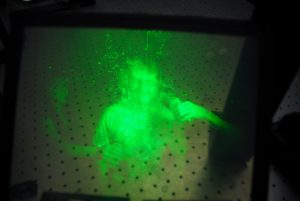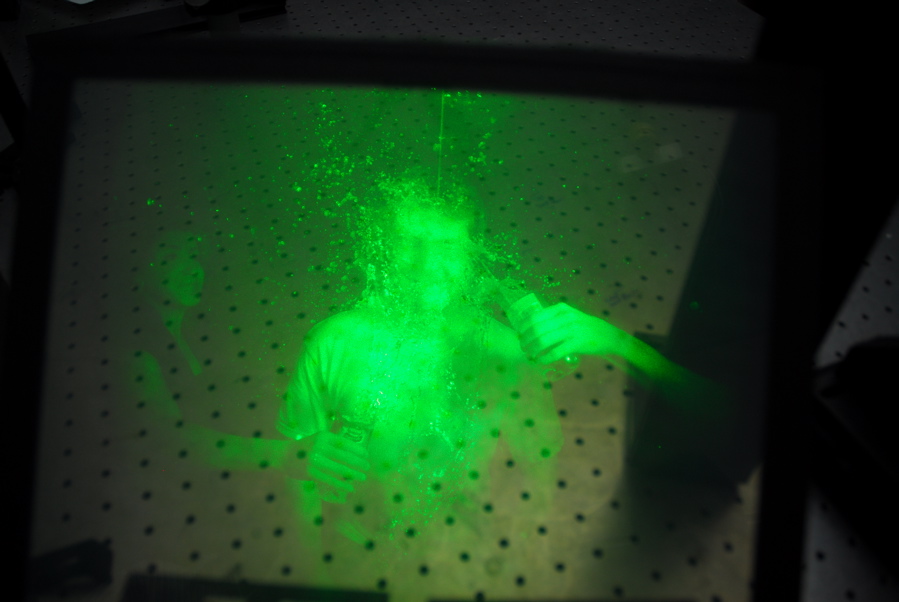I'm sure you've all seen the 'Math Lady' meme. You know, this one:

Well, that's me. (Not actually, but how I feel when I hear things like "formulas" and "equations.") I've always done well in the arts, English, music and other courses requiring creative merit but usually did poorly in those requiring memorization and rote memory. My grasp of math and science has always been rudimentary at best so I’ve done my best to dodge any and all courses that would require me to use the left hemisphere of my brain. Part of graduating from university ensures that you are prepared to (hopefully) find a career in your field, but it should also provide you with the opportunity to broaden your horizons and receive a well-rounded education. This is part of the reason why breadth requirements exist, with courses geared towards your academic stream while allowing you test the academic waters and possibly even have FUN while doing so.
While browsing for courses for second year, I came across IVP210, Holography for 3D Visualization, offered through the Impact Centre as a collaboration between Victoria College and the (gulp) Physics Department. As soon as I saw that, I was inundated with reminders of disappointing report cards and traumatic math/science class memories. Even though the application stated, “There are no prerequisites and no prior knowledge in any area is expected,” I was still apprehensive to apply.
I thought of Steve Jobs’ Stanford Commencement Address in which he discussed his time spent studying calligraphy while attending Reed College. Jobs studied the science and art of typography and developed a deeper appreciation for the history and aesthetics of fonts. Although this would not affect his life in the short-term, this knowledge would later be applied while developing the first Macintosh, which would be the “first computer with beautiful typography.” This also paved the way when Jobs invented the iPod and later, the iPhone, which were groundbreaking for their use of user-friendly and artistic interfaces. What I’m getting at is that I doubt Steve Jobs took calligraphy for any reason other than personal interest or possibly as a way to fulfill his breadth requirements yet this seemingly insignificant class changed the course of his career path and shaped many elements of the modern world as we know it.
So I applied for the course, and I got in. I started last week and I already love it. Much of the work is done in lecture and in lab with a hands-on approach to optics and 3D visualization. Better yet, the course is a mix of arts, computer science and physics students, and one of the requirements for the group projects is to team up with someone outside of your academic stream. This offers the chance to showcase my talents in the arts while collaborating with someone else’s strengths in an interdisciplinary setting. Even better, we get to make holograms! How cool is that?

If you’re interested in taking courses outside of your usual academic stream, the CR/NCR (credit/no credit) option allows you to explore your options without having to worry about how well you do in a course. As long as you pass the course, it will not affect your GPA provided that you add or remove the CR/NCR credit option before the deadline. If this is something that seems interesting to you, please visit the link below for more details or speak with your registrar's office about broadening your scholarly realm!
(Click here for information on the CR/NCR option)
 Well, that's me. (Not actually, but how I feel when I hear things like "formulas" and "equations.") I've always done well in the arts, English, music and other courses requiring creative merit but usually did poorly in those requiring memorization and rote memory. My grasp of math and science has always been rudimentary at best so I’ve done my best to dodge any and all courses that would require me to use the left hemisphere of my brain. Part of graduating from university ensures that you are prepared to (hopefully) find a career in your field, but it should also provide you with the opportunity to broaden your horizons and receive a well-rounded education. This is part of the reason why breadth requirements exist, with courses geared towards your academic stream while allowing you test the academic waters and possibly even have FUN while doing so.
While browsing for courses for second year, I came across IVP210, Holography for 3D Visualization, offered through the Impact Centre as a collaboration between Victoria College and the (gulp) Physics Department. As soon as I saw that, I was inundated with reminders of disappointing report cards and traumatic math/science class memories. Even though the application stated, “There are no prerequisites and no prior knowledge in any area is expected,” I was still apprehensive to apply.
I thought of Steve Jobs’ Stanford Commencement Address in which he discussed his time spent studying calligraphy while attending Reed College. Jobs studied the science and art of typography and developed a deeper appreciation for the history and aesthetics of fonts. Although this would not affect his life in the short-term, this knowledge would later be applied while developing the first Macintosh, which would be the “first computer with beautiful typography.” This also paved the way when Jobs invented the iPod and later, the iPhone, which were groundbreaking for their use of user-friendly and artistic interfaces. What I’m getting at is that I doubt Steve Jobs took calligraphy for any reason other than personal interest or possibly as a way to fulfill his breadth requirements yet this seemingly insignificant class changed the course of his career path and shaped many elements of the modern world as we know it.
So I applied for the course, and I got in. I started last week and I already love it. Much of the work is done in lecture and in lab with a hands-on approach to optics and 3D visualization. Better yet, the course is a mix of arts, computer science and physics students, and one of the requirements for the group projects is to team up with someone outside of your academic stream. This offers the chance to showcase my talents in the arts while collaborating with someone else’s strengths in an interdisciplinary setting. Even better, we get to make holograms! How cool is that?
Well, that's me. (Not actually, but how I feel when I hear things like "formulas" and "equations.") I've always done well in the arts, English, music and other courses requiring creative merit but usually did poorly in those requiring memorization and rote memory. My grasp of math and science has always been rudimentary at best so I’ve done my best to dodge any and all courses that would require me to use the left hemisphere of my brain. Part of graduating from university ensures that you are prepared to (hopefully) find a career in your field, but it should also provide you with the opportunity to broaden your horizons and receive a well-rounded education. This is part of the reason why breadth requirements exist, with courses geared towards your academic stream while allowing you test the academic waters and possibly even have FUN while doing so.
While browsing for courses for second year, I came across IVP210, Holography for 3D Visualization, offered through the Impact Centre as a collaboration between Victoria College and the (gulp) Physics Department. As soon as I saw that, I was inundated with reminders of disappointing report cards and traumatic math/science class memories. Even though the application stated, “There are no prerequisites and no prior knowledge in any area is expected,” I was still apprehensive to apply.
I thought of Steve Jobs’ Stanford Commencement Address in which he discussed his time spent studying calligraphy while attending Reed College. Jobs studied the science and art of typography and developed a deeper appreciation for the history and aesthetics of fonts. Although this would not affect his life in the short-term, this knowledge would later be applied while developing the first Macintosh, which would be the “first computer with beautiful typography.” This also paved the way when Jobs invented the iPod and later, the iPhone, which were groundbreaking for their use of user-friendly and artistic interfaces. What I’m getting at is that I doubt Steve Jobs took calligraphy for any reason other than personal interest or possibly as a way to fulfill his breadth requirements yet this seemingly insignificant class changed the course of his career path and shaped many elements of the modern world as we know it.
So I applied for the course, and I got in. I started last week and I already love it. Much of the work is done in lecture and in lab with a hands-on approach to optics and 3D visualization. Better yet, the course is a mix of arts, computer science and physics students, and one of the requirements for the group projects is to team up with someone outside of your academic stream. This offers the chance to showcase my talents in the arts while collaborating with someone else’s strengths in an interdisciplinary setting. Even better, we get to make holograms! How cool is that?
 If you’re interested in taking courses outside of your usual academic stream, the CR/NCR (credit/no credit) option allows you to explore your options without having to worry about how well you do in a course. As long as you pass the course, it will not affect your GPA provided that you add or remove the CR/NCR credit option before the deadline. If this is something that seems interesting to you, please visit the link below for more details or speak with your registrar's office about broadening your scholarly realm!
(Click here for information on the CR/NCR option)
If you’re interested in taking courses outside of your usual academic stream, the CR/NCR (credit/no credit) option allows you to explore your options without having to worry about how well you do in a course. As long as you pass the course, it will not affect your GPA provided that you add or remove the CR/NCR credit option before the deadline. If this is something that seems interesting to you, please visit the link below for more details or speak with your registrar's office about broadening your scholarly realm!
(Click here for information on the CR/NCR option)

0 comments on “Stepping Outside of My Academic Comfort Zone”